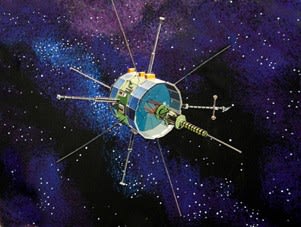Big-budget, Low-budget & Recycled Space Explorers
Follow articleHow do you feel about this article? Help us to provide better content for you.
Thank you! Your feedback has been received.
There was a problem submitting your feedback, please try again later.
What do you think of this article?
As I type this, a dramatic rescue operation is underway far out in space. OK it’s not exactly Apollo 13 and the spacecraft involved is an old unmanned NASA science probe called ISEE-3 launched back in 1978. At the same time the first ‘official’ UK CubeSat UKube-1 has begun orbiting the Earth. These low-budget projects have rather overshadowed the approaching climax of the big-budget ESA Rosetta mission to land a probe on a comet.
The International Sun/Earth Explorer 3 (ISEE-3) later re-tasked as the International Cometary Explorer (ICE) was pretty well shut down and apart from an occasional check to see if it was still alive, forgotten about until someone remembered that it was approaching Earth again. A group of engineers formed the ISEE-3 Reboot Project funded by a Kickstarter campaign and with permission and help from NASA re-established contact. Their aim is to re-light the engines and get it back into an orbit where it can do useful data gathering again given that most of the sensor equipment still works after 16 years. An attempt to fire the thrusters for trajectory change was made last week and each step was Tweeted via their Twitter channel @ISEE3Reboot . Unlikely as it seems, it was quite a nail-biting experience scrolling down my timeline following the live action from ‘mission control‘ (based in a re-cycled MacDonalds restaurant).
The attempt was unsuccessful, but a plea for help brought a cascade of advice from engineers around the world. Who says engineers and scientists don’t engage with social media? Since then some thruster firing has been achieved and more is planned. Even if ISEE-3 can’t be brought back into a more suitable orbit, it will still be in communication range for a few months and the on-board sensors are still capable of acquiring useful data – truly amazing considering that it’s been bombarded with radiation way beyond the design limit.
Meanwhile, low-budget CubeSat satellites continue to be launched, the latest being UKube-1, a pilot project of the UK Space Agency built by Clyde Space in Scotland. The satellite is a ‘technology demonstrator’ and its aim is not just to conduct experiments of limited interest to most people, but to stimulate student interest in STEM related subjects through the involvement of universities and schools. A detailed summary of the project objectives and technical details can be found here. The educational outreach part of the satellite is known as FUNcube-2 and follows on from the successful launch and operation of FUNcube-1 developed by AMSAT. A key feature of this project is the development of a FUNcube dongle, a radio receiver that plugs into a computer USB port. With the addition of a suitable antenna anybody can download the telemetry from these satellites. How’s that for public access!
At the big-budget end of the scale the European probe Rosetta with lander Philae is closing in on its quarry comet 67P/Churyumov-Gerasimenko, after 10 years in space. The spacecraft should arrive at the comet in August and deploy the Philae lander in November. An interesting issue has developed over access to ‘raw’ data from the probe. At the moment pictures are being released by esa at the rate of one a week because not unreasonably, the scientists and engineers who worked on the experiments want first crack at any discoveries. This is not an issue of government agencies wanting to keep everything secret as anyone who has been following the torrents of raw picture data coming from the Curiosity rover via NASA can see. The latest pictures of 67P coming from Rosetta revealing it to be spinning and shaped like a toy plastic duck, were actually leaked. For this sort of project to be justified a much better balance must be achieved between the needs of the scientists and the public who, one way or another paid for the whole enterprise.
If you're stuck for something to do, follow my posts on Twitter. I link to interesting new electronics components and development kits (some of them available from my employer!) and retweet posts I spot about robot, space exploration and other issues.





